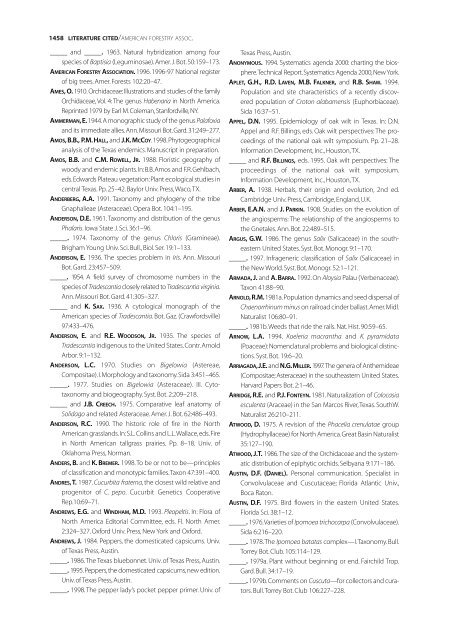References - Botanical Research Institute of Texas
References - Botanical Research Institute of Texas
References - Botanical Research Institute of Texas
You also want an ePaper? Increase the reach of your titles
YUMPU automatically turns print PDFs into web optimized ePapers that Google loves.
1458 LITERATURE CITED/AMERICAN FORESTRY ASSOC.<br />
_____ and _____. 1963. Natural hybridization among four<br />
species <strong>of</strong> Baptisia (Leguminosae). Amer. J. Bot. 50:159–173.<br />
AMERICAN FORESTRY ASSOCIATION. 1996. 1996-97 National register<br />
<strong>of</strong> big trees. Amer. Forests 102:20–47.<br />
AMES,O.1910. Orchidaceae: Illustrations and studies <strong>of</strong> the family<br />
Orchidaceae, Vol. 4: The genus Habenaria in North America.<br />
Reprinted 1979 by Earl M. Coleman, Stanfordville, NY.<br />
AMMERMAN,E.1944.A monographic study <strong>of</strong> the genus Palafoxia<br />
and its immediate allies.Ann.Missouri Bot.Gard.31:249–277.<br />
AMOS,B.B.,P.M.HALL, and J.K.MCCOY.1998.Phytogeographical<br />
analysis <strong>of</strong> the <strong>Texas</strong> endemics. Manuscript in preparation.<br />
AMOS, B.B.and C.M. ROWELL, JR. 1988. Floristic geography <strong>of</strong><br />
woody and endemic plants.In:B.B.Amos and F.R.Gehlbach,<br />
eds.Edwards Plateau vegetation:Plant ecological studies in<br />
central <strong>Texas</strong>. Pp. 25–42. Baylor Univ. Press,Waco,TX.<br />
ANDERBERG, A.A.1991. Taxonomy and phylogeny <strong>of</strong> the tribe<br />
Gnaphalieae (Asteraceae). Opera Bot. 104:1–195.<br />
ANDERSON,D.E.1961. Taxonomy and distribution <strong>of</strong> the genus<br />
Phalaris.Iowa State J. Sci. 36:1–96.<br />
_____. 1974. Taxonomy <strong>of</strong> the genus Chloris (Gramineae).<br />
Brigham Young Univ. Sci. Bull., Biol. Ser. 19:1–133.<br />
ANDERSON, E.1936. The species problem in Iris. Ann. Missouri<br />
Bot. Gard. 23:457–509.<br />
_____. 1954. A field survey <strong>of</strong> chromosome numbers in the<br />
species <strong>of</strong> Tradescantia closely related to Tradescantia virginia.<br />
Ann. Missouri Bot. Gard. 41:305–327.<br />
_____ and K. SAX. 1936. A cytological monograph <strong>of</strong> the<br />
American species <strong>of</strong> Tradescantia.Bot. Gaz. (Crawfordsville)<br />
97:433–476.<br />
ANDERSON, E.and R.E. WOODSON, JR. 1935. The species <strong>of</strong><br />
Tradescantia indigenous to the United States.Contr.Arnold<br />
Arbor. 9:1–132.<br />
ANDERSON, L.C. 1970. Studies on Bigelowia (Astereae,<br />
Compositae).I.Morphology and taxonomy.Sida 3:451–465.<br />
_____. 1977. Studies on Bigelowia (Asteraceae). III. Cytotaxonomy<br />
and biogeography. Syst. Bot. 2:209–218.<br />
_____ and J.B. CREECH. 1975. Comparative leaf anatomy <strong>of</strong><br />
Solidago and related Asteraceae. Amer. J. Bot. 62:486–493.<br />
ANDERSON, R.C.1990. The historic role <strong>of</strong> fire in the North<br />
American grasslands.In:S.L.Collins and L.L.Wallace,eds.Fire<br />
in North American tallgrass prairies. Pp. 8–18. Univ. <strong>of</strong><br />
Oklahoma Press, Norman.<br />
ANDERS,B.and K. BREMER. 1998. To be or not to be—principles<br />
<strong>of</strong> classification and monotypic families.Taxon 47:391–400.<br />
ANDRES,T. 1987. Cucurbita fraterna, the closest wild relative and<br />
progenitor <strong>of</strong> C. pepo. Cucurbit Genetics Cooperative<br />
Rep.10:69–71.<br />
ANDREWS, E.G.and WINDHAM, M.D.1993. Pleopeltis.In:Flora <strong>of</strong><br />
North America Editorial Committee, eds. Fl. North Amer.<br />
2:324–327. Oxford Univ. Press, New York and Oxford.<br />
ANDREWS,J.1984. Peppers, the domesticated capsicums. Univ.<br />
<strong>of</strong> <strong>Texas</strong> Press, Austin.<br />
_____. 1986.The <strong>Texas</strong> bluebonnet. Univ. <strong>of</strong> <strong>Texas</strong> Press, Austin.<br />
_____. 1995.Peppers,the domesticated capsicums,new edition.<br />
Univ. <strong>of</strong> <strong>Texas</strong> Press, Austin.<br />
_____. 1998. The pepper lady’s pocket pepper primer. Univ. <strong>of</strong><br />
<strong>Texas</strong> Press, Austin.<br />
ANONYMOUS. 1994. Systematics agenda 2000: charting the biosphere.Technical<br />
Report.Systematics Agenda 2000,New York.<br />
APLET, G.H., R.D. LAVEN, M.B.FALKNER, and R.B. SHAW. 1994.<br />
Population and site characteristics <strong>of</strong> a recently discovered<br />
population <strong>of</strong> Croton alabamensis (Euphorbiaceae).<br />
Sida 16:37–51.<br />
APPEL, D.N.1995. Epidemiology <strong>of</strong> oak wilt in <strong>Texas</strong>. In: D.N.<br />
Appel and R.F. Billings, eds. Oak wilt perspectives: The proceedings<br />
<strong>of</strong> the national oak wilt symposium. Pp. 21–28.<br />
Information Development, Inc., Houston,TX.<br />
_____ and R.F. BILLINGS, eds. 1995. Oak wilt perspectives: The<br />
proceedings <strong>of</strong> the national oak wilt symposium.<br />
Information Development, Inc., Houston,TX.<br />
ARBER, A.1938. Herbals, their origin and evolution, 2nd ed.<br />
Cambridge Univ. Press, Cambridge, England, U.K.<br />
ARBER,E.A.N. and J. PARKIN. 1908. Studies on the evolution <strong>of</strong><br />
the angiosperms: The relationship <strong>of</strong> the angiosperms to<br />
the Gnetales. Ann. Bot. 22:489–515.<br />
ARGUS, G.W.1986. The genus Salix (Salicaceae) in the southeastern<br />
United States. Syst. Bot. Monogr. 9:1–170.<br />
_____. 1997. Infrageneric classification <strong>of</strong> Salix (Salicaceae) in<br />
the New World. Syst. Bot. Monogr. 52:1–121.<br />
ARMADA,J.and A. BARRA. 1992. On Aloysia Palau (Verbenaceae).<br />
Taxon 41:88–90.<br />
ARNOLD,R.M.1981a.Population dynamics and seed dispersal <strong>of</strong><br />
Chaenorrhinum minus on railroad cinder ballast.Amer.Midl.<br />
Naturalist 106:80–91.<br />
_____. 1981b.Weeds that ride the rails. Nat. Hist. 90:59–65.<br />
ARNOW, L.A.1994. Koeleria macrantha and K. pyramidata<br />
(Poaceae): Nomenclatural problems and biological distinctions.<br />
Syst. Bot. 19:6–20.<br />
ARRIAGADA,J.E.and N.G.MILLER. 1997. The genera <strong>of</strong> Anthemideae<br />
(Compositae; Asteraceae) in the southeastern United States.<br />
Harvard Papers Bot. 2:1–46.<br />
ARRIDGE,R.E.and P.J. FONTEYN. 1981. Naturalization <strong>of</strong> Colocasia<br />
esculenta (Araceae) in the San Marcos River,<strong>Texas</strong>. SouthW.<br />
Naturalist 26:210–211.<br />
ATWOOD, D.1975. A revision <strong>of</strong> the Phacelia crenulatae group<br />
(Hydrophyllaceae) for North America.Great Basin Naturalist<br />
35:127–190.<br />
ATWOOD,J.T.1986. The size <strong>of</strong> the Orchidaceae and the systematic<br />
distribution <strong>of</strong> epiphytic orchids. Selbyana 9:171–186.<br />
AUSTIN, D.F.(DANIEL). Personal communication. Specialist in<br />
Convolvulaceae and Cuscutaceae; Florida Atlantic Univ.,<br />
Boca Raton.<br />
AUSTIN, D.F.1975. Bird flowers in the eastern United States.<br />
Florida Sci. 38:1–12.<br />
_____. 1976.Varieties <strong>of</strong> Ipomoea trichocarpa (Convolvulaceae).<br />
Sida 6:216–220.<br />
_____. 1978.The Ipomoea batatas complex—I.Taxonomy. Bull.<br />
Torrey Bot. Club. 105:114–129.<br />
_____. 1979a. Plant without beginning or end. Fairchild Trop.<br />
Gard. Bull. 34:17–19.<br />
_____. 1979b.Comments on Cuscuta—for collectors and curators.<br />
Bull.Torrey Bot. Club 106:227–228.
















